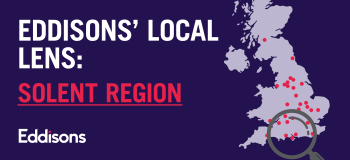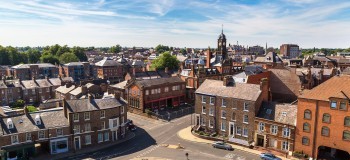17/07/2024
Insights
Planning Director, Kate Wood, Kate Wood, pushes for a wider and more realistic definition of Grey Belt after Rachel Reeves, the new Chancellor of the Exchequer, recently announced a review of the Green Belt.
Why Review the Green Belt and How Does Its Designation Affect Development?
The recent announcement by Rachel Reeves, the new Chancellor of the Exchequer, outlined that the Green Belt is to be reviewed and that land newly termed as ‘Grey Belt’ should be released for development. This move marks a significant step towards reevaluating the purpose and function of the Green Belt.
The Green Belt, as a designation of land, has been around since the 1950s but so much has changed in England since then that the requirement to now review them is welcomed.
Just to remind ourselves, the purpose of Green Belts is to prevent urban sprawl and the merging of towns into each other by keeping this designated land permanently open.
Operationally, this means that planning applications in the Green Belt are considered on the basis of whether they keep land open and in rural character. This, effectively, prevents most development.
Some exceptions are allowed, such as cemeteries, motorway service areas and affordable housing. Otherwise, it is necessary to demonstrate ‘Very Special Circumstances’ (VSCs) to overcome the ‘harm’ to the Green Belt from a proposed development. Even a dire need for housing is sometimes deemed insufficient to demonstrate VSCs.
It’s also worth noting that Green Belt designation is not about beautiful or special countryside, habitats or similar. There are other designations that cover those issues, such as National Landscapes (formerly AONBs - Areas of Outstanding Natural Beauty). Green Belts are only for openness and prevention of sprawl and merging.
What is the Concept of the Grey Belt?
Against this background the idea of the ‘Grey Belt’ is being promoted to describe sites that are ugly and, often, previously developed. Such sites can still be considered to have an open character, hence the need to define them specifically as exceptions to enable their development.
Grey Belt has been calculated by some professional bodies to be up to 3% of the Green Belt. It is clearly a palatable first step that can be understood and generally agreed with by those wishing to protect the Green Belt for a variety of reasons - some of which do not relate to the Green Belt’s primary purpose.
What Are the Benefits and Challenges of Developing Grey Belt Land?
There is the potential to build a lot of houses on Grey Belt land. However, in being previously developed land, there may be site contamination or similar challenges that won’t necessarily be straightforward or, crucially, financially viable for developers to overcome.
There is a risk to affordable housing, this being often the first thing to be lost when the costs of development versus the potential profit don’t make the development worthwhile.
Nobody is going to build a scheme for no profit - that’s simply business.
However, affordable housing is often needed most in areas within or surrounded by Green Belt because development has been stifled for so long that the area’s house prices are pushed up.
So, whilst Grey Belt is a start, nobody should consider this as the whole answer to the national housing shortage.
Why Do We Need to Rethink Green Belt Boundaries?
When I started out in planning in Essex in the early 1990s, the Metropolitan Green Belt affected some of the District areas within the county. We had Local Plan maps with areas we called, at the time, ‘White Land’.
The recent discussion of a Grey Belt category reminded me of this colour-related definition, which was, effectively, land which wasn’t in the Green Belt or within village/town development limits - ie it had no designation and was, thereby, just considered ‘countryside’.
A review of Green Belt boundaries against the purposes of maintaining openness and preventing sprawl and merging would, I suggest, throw up a lot of such land that doesn’t fit genuine Green Belt or the new Grey Belt definitions.
For instance, a few years ago, I had a client with a small field in the Cambridge Green Belt that could have accommodated 30 houses. It was on the edge of a village so just outside the village limits drawn on the Local Plan map. It was entirely enclosed by well-established thick belts of trees and vegetation. It was ‘open’ land in itself but could not be considered to contribute to the openness of the Green Belt, nor would it result in sprawl from Cambridge (being a village within the Green Belt) or the merging of settlements.
However, as it was in the designated Green Belt, its development was unacceptable in principle, even though the nearby primary school was at risk of closure and was taking in pupils from out of catchment. It could only then progress for development by allocating the site in the next Local Plan, which is the only way to change Green Belt boundaries, and, therefore, results in significant delay and uncertainty.
This made me realise that the way Green Belts were designated needed a rethink. In my experience, the way Green Belts have been designated is to draw a line around the edge of the city/town, representing the inner boundary. Then a line several miles further out is drawn to represent the outer boundary, thereby creating a ‘doughnut’ ring.
Within that ring, villages have lines drawn around them as Village Development Limits in the normal way, and everything outside these limits is ‘Green-washed’, literally with watercolour paint on the older maps. This is the process by which land has arrived in the Green Belt that, arguably, should not be there.
Just because land is outside the Village Development Limits, it should not necessarily be designated as Green Belt without further consideration. This is where the definition of Grey Belt can be extended and refined. It would then be treated as just countryside with relevant policies applying. My client’s field would have been Grey Belt and could then have benefitted from policies permitting development on the edges of villages, infill sites, etc.
Assessing land against the purpose of Green Belts rather than how it looks needs to be the focus of the Green Belt review required by the new Government, whereby a more appropriate definition of Grey Belt will result in a more genuine Green Belt that can be better protected in the long term.






